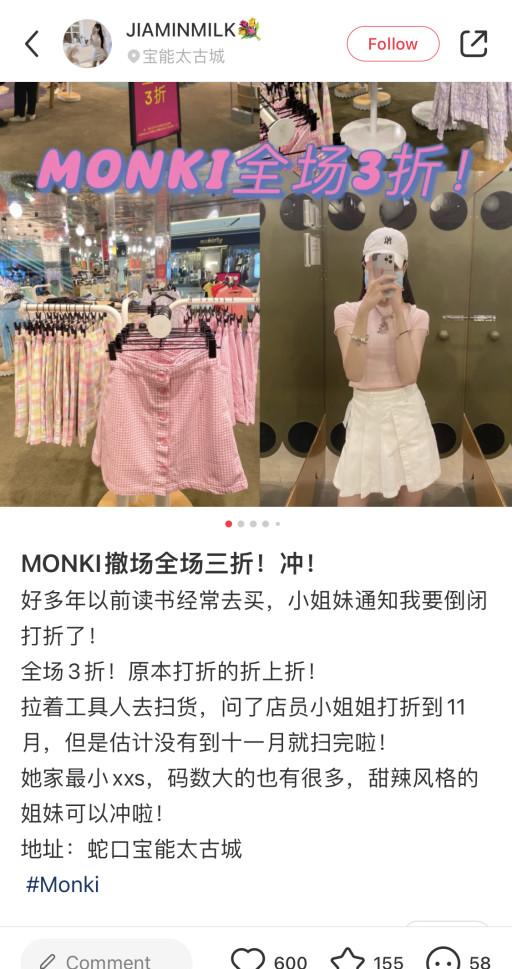Reporter | Chen Qirui
Edit | Lou Shuqin
1
Although the ultra-fast fashion brands represented by Shein and Fashionnova have grown rapidly during the epidemic, and Zara's revenue has gradually returned to pre-epidemic levels, the fast fashion winter that has plagued the industry in the past few years has not left.
According to Hong Kong 01, Monki, a low-price fast fashion brand owned by the Swedish H&M Group, is about to withdraw from the Hong Kong market in China, and the last store in Tsuen Wan Plaza is expected to close in two weeks. According to the report, after the store is closed, the clerk can choose to work in other stores under the H&M Group brand.
The Hong Kong market is a must for a number of international fast fashion brands, with Topshop and Forever 21 opening large stores in commercial centres such as Central and Causeway Bay respectively. However, the turmoil in the retail industry, coupled with the impact of the epidemic, has had an impact on the fast fashion retail market in Hong Kong. Before Monki announced the closure of its Tsuen Wan Plaza store, H&M had already closed four stores in a row in Hong Kong.
However, compared to H&M's huge store size around the world, the smaller Monki is obviously more seriously affected. On social media such as Xiaohongshu and Weibo, a large number of netizens posted that the Monki store in the city was undergoing clearance discounts and was suspected of closing the store.

Before the winter of fast fashion escalated, Monki had already encountered setbacks in the Japanese market. Faced with a strong local fashion culture, Monki announced in 2016 that it would close all stores and withdraw from the Japanese market. H&M said exiting the Japanese market was part of a business plan to open more stores in Europe, Chinese mainland and Hong Kong.
However, from the reality of the situation, the expansion plan formulated by H&M Group for Monki has obviously not achieved the expected results, and the group itself is facing challenges. H&M Group's net sales increased by 14% year-on-year to SEK 55.59 billion, but sales in Asia and Oceania fell 17% year-on-year, becoming H&M Group's only market where sales declined in the quarter, while Chinese mainland had fallen from the list of the top 10 markets.
At present, H&M will focus on the Chinese mainland market on the three mid-range brands of COS, Arket and Other Stories, of which COS is accelerating its expansion from first-tier and non-first-tier cities to sinking markets, and is on the sales list of shopping festivals such as "Double 11" and "6.18" through live broadcast. Arket and & Other Stories officially entered the Chinese mainland market in the fall of 2021 and are now opening stores in Beijing and Shanghai.
Image credit: Drapers
While H&M Group is busy changing its image, rival Inditex Group is about to enter a transformation. Marta Ortega, daughter of Zara founder Amancio Ortega, will officially assume the role of group chairman in April 2022, and she has been involved in the development of projects such as Zara Beauty.
Notably, Inditex Group has also recently searched for a number of smaller fast fashion brands, with Bershka, Pull & Bear, and Stradivarius announcing their exit from the Chinese market in early 2021. Inditex Group responded that the three brands will connect with Chinese consumers through online channels in the future.
But whether it is H&M Group or Inditex Group, it is undeniable that the low-priced fast fashion brands originally established to further seize the market are no longer in the competitive landscape suitable for the current market. Among the low-priced brands founded by traditional fast fashion companies, only a few brands such as Gap Group's Old Navy are still growing steadily, but these brands are also larger.
It can also be seen that the integration of business and the development of high-end are the two main lines of the transformation and development of the current traditional fast fashion group. Under the impact of low-cost ultra-fast fashion brands such as Shein, Fashionnova and Primark, the speed of traditional fast fashion group competition has no longer brought the advantage of opening up the gap. Compared with "fast", they now need to emphasize the "fashion" part of themselves to enhance consumer loyalty.